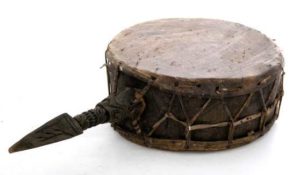
Types of fingerpicking on the guitar, or how to play a beautiful accompaniment?
Contents
Beginning guitarists, having heard a new song, often wonder: what fingering is used to play the accompaniment? Or what is the best way to play a composition if we are talking about an arrangement for one guitar?
It is impossible to answer these questions unambiguously. To a large extent, the choice will depend on the artistic taste and individual style of the performer. There are a great many options for this method of sound production.
A guitarist must regularly replenish his musical arsenal with various types of fingerpicking. The more the performer has, the better, the more beautiful and original the chords of the song will sound. In addition, the means of expression are significantly expanded to more subtly convey mood and emotions to the listener.
For example, the great Italian guitarist M. Giuliani at one time developed 120 fingerpicks. They are presented as separate exercises and divided into 10 separate groups. These achievements of the great master undoubtedly deserve praise and seem to be fertile ground for the cultivation of his ideas.
A little theory before class
What is fingerpicking from the point of view of music theory? This is an arpeggio – alternately extracting the sounds of a chord: from the lowest note to the highest (ascending) and vice versa (descending). The sounds of a chord can vary in order.
This article will discuss the most common and easiest to perform types of arpeggios used in guitar accompaniment.
In the exercises, next to each arpeggio note there is a designation indicating which finger of the right hand needs to be played. The entire diagram can be seen in the drawing with a hand.
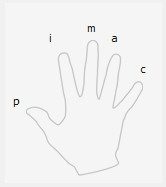 To quickly remember the correspondence of Latin letters to each finger, you need to conditionally combine them into one word “pimac“ and, as it were, pronounce it letter by letter, mentally moving your fingers, starting from the thumb.
To quickly remember the correspondence of Latin letters to each finger, you need to conditionally combine them into one word “pimac“ and, as it were, pronounce it letter by letter, mentally moving your fingers, starting from the thumb.
In some exercises there are chords with complex alphanumeric symbols – do not pay attention if they are difficult to understand, you can return to this topic later, now the main task is to master the types of picking. All chords are easy to play and are not particularly difficult.
Types of guitar picking (arpeggios)

This type of arpeggio uses only three strings. First you need to analyze which note, which finger to play. You must strictly adhere to the fingering of the right hand. First, picking is practiced on open strings, this allows you to concentrate more on honing your technique. Once you feel confident, you can play chord progressions using this method.
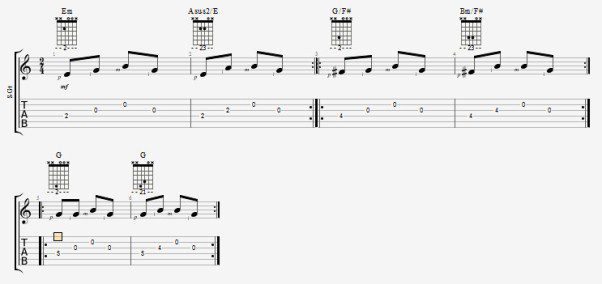
Don’t forget about reprises – repetition of bars 1 and 2, bars 3 and 4, 5 and 6. The guitar grids indicate the right hand fingering.

It is played very simply – the bass string, and alternately plucking the strings, starting from the third to the first and back. This type of arpeggio, despite its triviality, can sound quite impressive. A striking example is the accompaniment in the second verse of Harry Moore’s beautiful blues ballad – still got the blues. Watch the video with this music:
Having become comfortable with open strings, you can start playing chords:


Two small exercises in C major and A minor
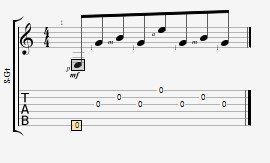
Mastering this type of arpeggio may seem incredibly difficult at first. Although upon closer examination there is nothing overly complex in it. The first four sounds of this picking are nothing more than the picking discussed in the first exercise, then there is sound production on the first string, and again 3,2 and again the 3rd string. To play this arpeggio, you need to start at a very slow tempo, controlling the order in which the sounds are extracted with the corresponding fingers.
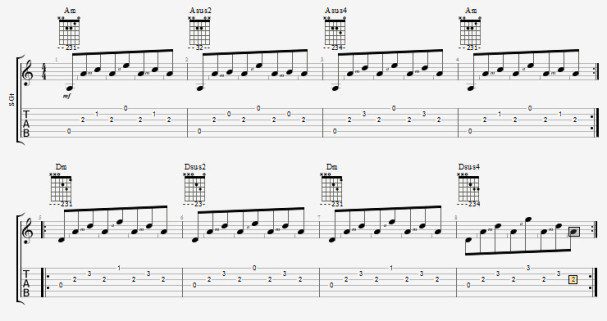
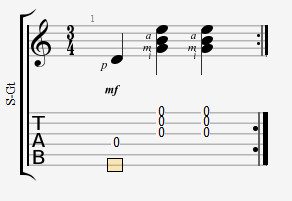
Fingers i,m,a are, as it were, preliminarily placed behind the strings, in this correspondence i -3 ,m -2, a -1 (but the sound is not yet produced). Then strike the bass string and simultaneously pluck with three fingers. Count rhythmically – one, two, three – one, two, three – etc.
Notice how the bass string changes alternately in each measure, imitating a bass line:
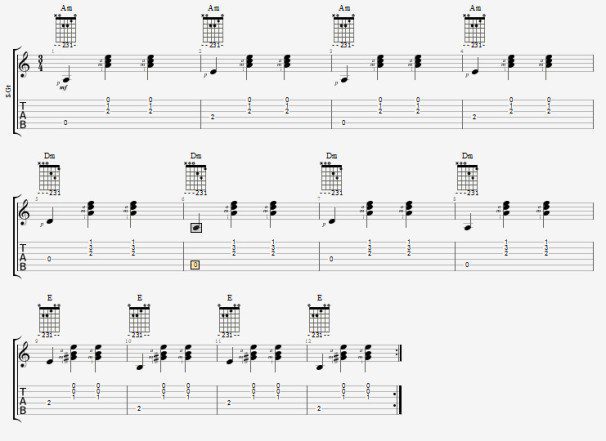
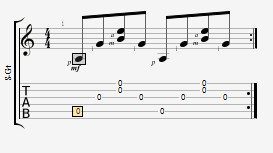
This type of arpeggio is very often used in classical romances. Strings 2 and 1 are plucked at the same time. As you can see, often the types of fingerpicking and their choice depend precisely on what genre a particular song belongs to. You can read something about genres here – “Main musical genres.” And here is a version of this search in A minor:
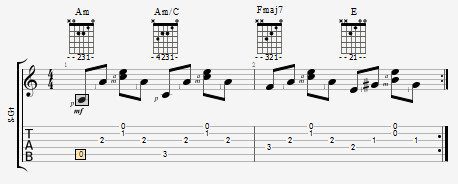
With increasing performing experience, the clear boundaries in the concept of “type of fingerpicking” are erased; each chord in a song can be emphasized by different strokes. An arpeggio can stretch over several measures and transform rhythmically, expressing the nature of the theme.
Exercises for practicing arpeggios do not need to be played mechanically and mindlessly. At a slow tempo, maintaining the time signature evenly – first on open strings and then with chords. The sequences in the exercises are just examples; arpeggios can be played arbitrarily according to the harmony you like.
Exercises should not be tiring. If you feel tired and more and more mistakes are being made, it would be wiser to rest for a while and start studying again. If you are completely new to playing the guitar, then read this – “Exercises for Beginning Guitarists”
If you want to take a full course on playing the guitar, then go here:
Beautiful picking and original sound!



